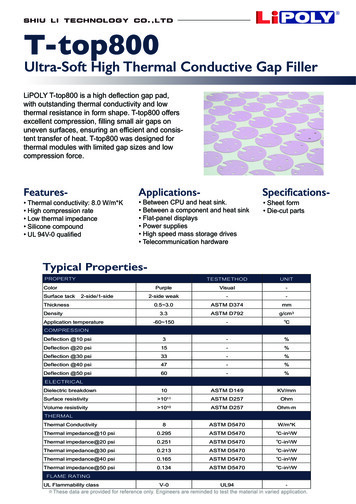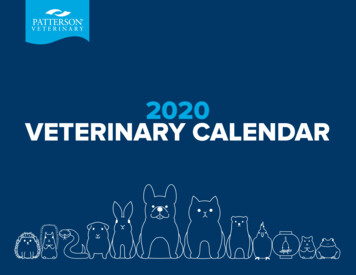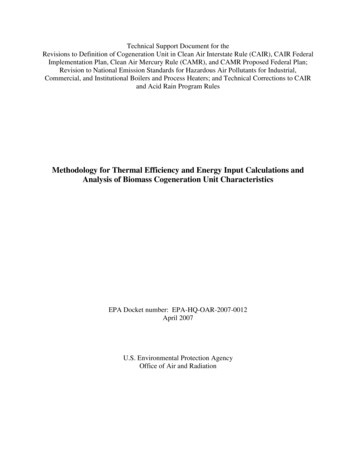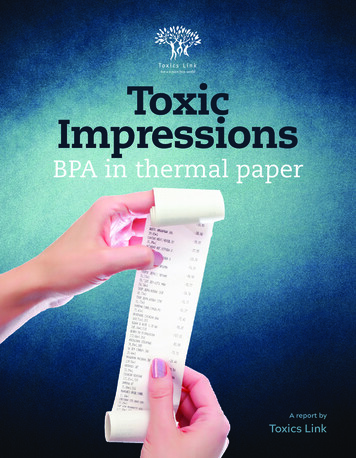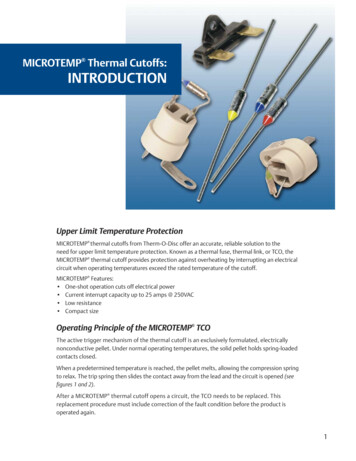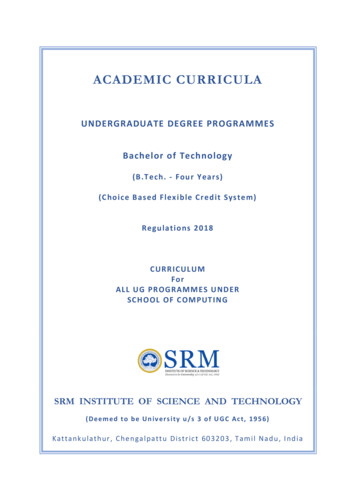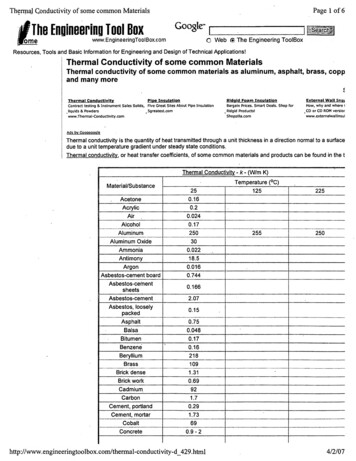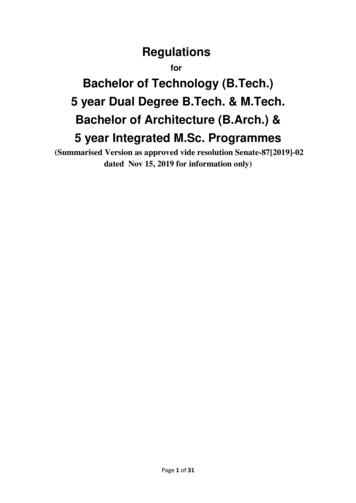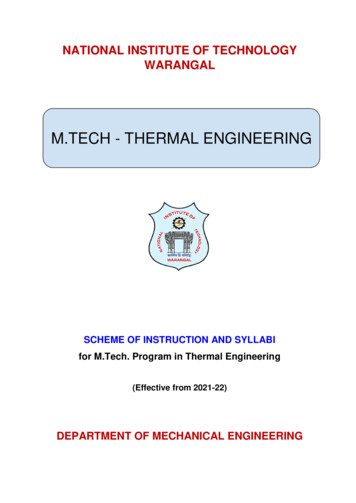
Transcription
NATIONAL INSTITUTE OF TECHNOLOGYWARANGALM.TECH - THERMAL ENGINEERINGSCHEME OF INSTRUCTION AND SYLLABIfor M.Tech. Program in Thermal Engineering(Effective from 2021-22)DEPARTMENT OF MECHANICAL ENGINEERING
Department of Mechanical EngineeringVision and Mission of the InstituteNational Institute of Technology WarangalVISIONTowards a Global Knowledge Hub, striving continuously in pursuit of excellence inEducation, Research, Entrepreneurship and Technological services to the societyMISSION Imparting total quality education to develop innovative, entrepreneurial and ethicalfuture professionals fit for globally competitive environment. Allowing stakeholders to share our reservoir of experience in education andknowledge for mutual enrichment in the field of technical education. Fostering product-oriented research for establishing a self-sustaining and wealthcreating centre to serve the societal needs.Vision and Mission of the DepartmentDepartment of Mechanical EngineeringVISIONTo be a global knowledge hub in mechanical engineering education, research,entrepreneurship and industry outreach services.MISSION Impart quality education and training to nurture globally competitive mechanicalengineers. Provide vital state-of-the-art research facilities to create, interpret, apply anddisseminate knowledge. Develop linkages with world class educational institutions and R&D organizations forexcellence in teaching, research and consultancy services.Scheme and Syllabiw.e.f. 2021-22
Department of Mechanical EngineeringDepartment of Mechanical Engineering:Brief about the Department:The Department of Mechanical Engineering was established in the year 1959. The departmentpresently offers one Under Graduate Programme, i.e., B.Tech in Mechanical Engineering withan intake of 170 students, seven M.Tech programs - Thermal Engineering, ManufacturingEngineering, Computer Integrated Manufacturing, Machine Design, Automobile Engineering,Materials and Systems Engineering Design, Additive Manufacturing, - one PG Diploma inAdditive Manufacturing and Ph.D programs. At present, the Department has 48 facultymembers with research expertise in different specializations of Mechanical Engineering. TheDepartment has good research facilities for both experimental as well as simulation-basedresearch. The department has liaison with reputed industries and R&D organizations such asNFTDC, DMRL, DRDL, ARCI, BHEL, CPRI, CMTI etc. All the faculty of the department areactively engaged in R&D and Consultancy. Presently the department is handling about 25funded projects worth Rs. 3.00 Crores. The department has recently acquired Metal 3D Printerat a cost of Rs.1.4 Crores under TEQIP -III grants. The institute is establishing SIEMENS Centreof Excellence in Digital Manufacturing and Industry 4.o in which the department is playing a keyrole. The department produces a large number of publications, and offers solutions to theindustry regularly and is also active with regular outreach activities like workshops, conferencesand executive programs for industry personnel. The department has been recognized as QIPCentre for M.Tech and Ph. D. programmes.List of Programs offered by the Department:ProgramB.Tech.M.Tech.PG DiplomaPh.D.Title of the ProgramMechanical EngineeringThermal EngineeringAutomobile EngineeringManufacturing EngineeringMachine DesignComputer Integrated ManufacturingMaterials and Systems Engineering DesignAdditive ManufacturingAdditive ManufacturingMechanical EngineeringNote: Refer to the following weblink for Rules and Regulations of M.Tech. ulesandregulations/Scheme and Syllabiw.e.f. 2021-22
Department of Mechanical EngineeringM.Tech. – Thermal EngineeringProgram Educational ObjectivesProgram Educational Objectives (PEOs) are broad statements that describe the career andprofessional accomplishments that the program is preparing graduates to achieve. They areconsistent with the mission of the Institution and Department. Department faculty memberscontinuously worked with stakeholders (local employers, industry and R&D advisors and thealumni) to review the PEOs and update them periodically.PEO-1PEO-2PEO-3PEO-4Analyze, design and evaluate thermal systems using state of the artengineering tools and techniquesDevelop methods of energy conservation for sustainable growthCommunicate effectively and support constructively towards team workPursue lifelong learning for professional growth with ethical concern for societyand environmentProgram Articulation MatrixPEOMission StatementsImparting quality education to the students andenhancing their skills to make them globallycompetitive mechanical engineers.Maintaining vital, state-of-the-art researchfacilities to provide its students and faculty withopportunities to create, interpret, apply anddisseminate knowledge.To develop linkages with world class R&Dorganizations and educational institutions in Indiaand abroad for excellence in teaching, researchand consultancy practices.1-Slightly;Scheme and 333-Substantiallyw.e.f. 2021-22
Department of Mechanical EngineeringM.Tech. – Thermal EngineeringProgram OutcomesProgram Outcomes (POs) are narrower statements that describe what the students areexpected to know and be able to do upon graduation. These relate to the knowledge, skills andbehavior the students acquire through the program. The POs are specific to the program andfacilitate the attainment of PEOs.PO-1PO-2PO-3PO-4PO-5PO-6Carryout independent research/investigation and development work to solvepractical problemsWrite and present a substantial technical report/documentDemonstrate a degree of mastery over thermal engineering at a level higher thanthe Bachelor’s program.Design, develop and analyze thermal systems for improved performance.Develop effective technologies to harness viable energy sources.Engage in lifelong learning adhering to professional, ethical, legal, safety,environmental and societal aspects for career excellence.Mapping of Program Outcomes with Program Educational me and Syllabi2-Moderately;3-Substantiallyw.e.f. 2021-22
Department of Mechanical EngineeringCredits in Each SemesterI Year,Sem – II Year,Sem – IIII Year,Sem – III Year,Sem – IITotal No. ofcredits to beearnedCore courses1206----18Electives0612----18Lab 080CategoryScheme and Syllabiw.e.f. 2021-22
Department of Mechanical EngineeringSCHEME OF INSTRUCTIONM.Tech. Thermal Engineering – Course StructureI - Year, I – Semester1CourseCodeME51012ME51023ME51034ME5104S. CPECPCCPCCSEMCourse TitleLTPCreditsGas Turbines and Jet PropulsionDesign and Optimization of ThermalSystemsElective – 3Elective – 4Elective – 5Elective – 6Simulation LaboratoryEnergy Systems EMCourse TitleAdvanced Fluid DynamicsComputational Methods in ThermalEngineeringAdvanced Heat and Mass TransferExperimental Methods in ThermalEngineeringElective – 1Elective – 2Thermal Engineering LaboratoryCFD LaboratorySeminar-ITotalI - Year, II – Semester1CourseCodeME51512ME5152S. No.3456789ME5153ME5154ME5198II - Year, I – SemesterS. No.12CourseCodeME6147ME6149Course TitleCreditsComprehensive Viva-voceDissertation Part-ATotal21214Cat.CodeCVVDWII - Year, II – SemesterS. No.1CourseCodeME6199Course TitleDissertation Part-BTotalNote: PCC – Professional Core CourseScheme and SyllabiCreditsCat.CodeDW2020PEC – Professional Elective Coursew.e.f. 2021-22
Department of Mechanical EngineeringList of Professional Elective Courses (M.Tech – Thermal Engineering)I Year, I SemesterCourseCourse TitleL-T-P CreditsCodeProgram Specific Professional Elective Courses1ME5111Refrigeration Technology3-0-032ME5112Power Plant Engineering3-0-033ME5113Renewable Sources of Energy3-0-034ME5114Energy Systems and Management3-0-035ME5115Hydraulic Machinery3-0-036ME5116Particle Mechanics and its Applications3-0-03Elective Courses from M.Tech Automobile EngineeringComputational Methods in Automobile1ME55023-0-03Engineering2ME5504Prime Movers for Automobiles3-0-033ME5513Alternate Fuels and Emissions3-0-03Elective Courses from M.Tech Machine Design1ME5404Computer Aided Geometric Design3-0-032ME5415Mathematical Methods in Engineering3-0-03Elective Courses from M.Tech Computer Integrated Manufacturing1ME5311Enterprise Resource Planning3-0-032ME5313Soft Computing Techniques3-0-03Elective Courses from M.Tech Materials and Systems Engineering Design1ME5611Surface Engineering3-0-03S. No.Scheme and CPECPECw.e.f. 2021-22
Department of Mechanical EngineeringList of Professional Elective Courses (M.Tech – Thermal Engineering)I Year, II SemesterCourseCourse TitleL-T-PCodeProgram Specific Elective CoursesHeating, Ventilation and Air Conditioning1ME51613-0-0(HVAC)Advanced Computational Fluid2ME51623-0-0Dynamics3ME5163Convective Heat and Mass Transfer3-0-04ME5164Conduction and Radiation Heat Transfer 3-0-05ME5165Two-Phase Heat Transfer3-0-06ME5166Design of Heat Transfer Equipment3-0-07ME5167Turbulent Flows3-0-08ME5168Industrial Heat Transfer3-0-09ME5169Rocket Propulsion3-0-010ME5170Essentials of Entrepreneurship3-0-011ME5171Combustion and Emission Control3-0-012ME5172Solar Energy Systems3-0-0Energy Conservation and Waste Heat13ME51733-0-0RecoveryFluid and Heat Transport through14ME51743-0-0Porous MediaElective Courses from M.Tech Automobile Engineering1ME5561Fuel Cell Technology3-0-02ME5564Hybrid Electric Vehicles3-0-0Elective Courses from M.Tech Machine DesignOptimization Methods for Engineering1ME54693-0-0DesignElective Courses from M.Tech Computer Integrated Manufacturing1ME5368Industry 4.o and IIoT3-0-02ME5370Project Management3-0-03ME5371AI and ML for Mechanical Systems3-0-0S. No.Scheme and ECw.e.f. 2021-22
Department of Mechanical EngineeringDETAILED SYLLABUSM.Tech. – Thermal EngineeringScheme and Syllabiw.e.f. 2021-22
Department of Mechanical EngineeringCourseCode:ME5101Credits3-0-0: 3ADVANCED FLUID DYNAMICSPrerequisites: NILCourse Outcomes:At the end of the course, the student will be able to:CO1Ascertain basic concepts of the fluid mechanics and apply the concepts in theanalysis of fluid flow problemsCO2Analyze the stress, strain and forces involving in the fluid element and to derive thegoverning equationsCO3Find the exact and approximate solutions of the governing equations for realisticflow situationsCO4Analyze the performance of fluid flow in laminar and turbulent flowsCO5Differentiate compressible and incompressible flows and solve compressible flowproblemsCourse Articulation 12CO4323312CO5322312Syllabus:Introduction: Review of the fundamentals of Fluid mechanics.Kinematics of Fluids: Lagrangean and Eulerian systems, Velocity potential, Stream functionand Vorticity.General theory of Stress and Rate of Strain: Stress-strain relations.Fundamental Conservation Equations: Integral and differential forms.One-dimensional Inviscid Incompressible Flow: Euler’s equation and Bernoulli’s equationapplications of Bernoulli's equation.Exact solutions of Navier-Stokes Equations: Couette flow, Hagen-Poiseuille flow, Flowbetween coaxial and concentric rotating cylinders, Hydrodynamic theory of lubrication,Creeping flows, Unsteady motion of flat plate.The Laminar Boundary Layer: Prandtl’s Boundary Layer Equations, Blasius solution,Momentum-integral equations and its applications, Boundary layer separation and control.Scheme and Syllabiw.e.f. 2021-22
Department of Mechanical EngineeringTurbulent Flows: Introduction to Turbulent Flow, Reynolds modification of N-S equations,Semi - empirical theories, Turbulent boundary layer for internal and external flows, Turbulencemodelling.Dimensional Analysis: Flow over a bluff body – Lift and Drag, Dimensional analysis andsimilitude.Introduction to Compressible Flow: Isentropic flow, Flow across normal and oblique shocks,Fanno flow, Rayleigh flow, Expansion waves.Learning Resources:Text Books:1. Introduction to Fluid Mechanics, Fox, R.W., Pritchard, P. J. and McDonald, A. T., Wiley, 2018,8th Edition.2. Viscous Fluid Flow, White, F. M., Tata McGraw Hill Book Company, 2021, 4th Edition.Reference Books:1. Foundations of Fluid Mechanics, Yuan, S. W., Prentice Hall of India, 20002. Fundamentals of Compressible Flow with Aircraft and Rocket Propulsion, Yahya, S. M., NewAge International Publishers, 2018, 6th Edition.3. Modern Compressible Flow –with Historical Perspective, Anderson, J. D. Jr., TMH, 2020, 4thedition.4. Boundary Layer Theory, Schlichting, H and Gersten, K, 9th Edition, Springer, 2018.5. Advanced Engineering Fluid Mechanics, Muralidhar, K and Biswas, G., Alpha ScienceInternational Ltd.,3rd Edition, 2018.Online Resources:1. Advanced Fluid Mechanics by Dr. Suman Chakraborty (IIT Kharagpur), NPTEL Course 8/#)2. Introduction to Turbulence by Prof. Gautam Biswas (IIT Kanpur), NPTEL Course 0/)Scheme and Syllabiw.e.f. 2021-22
Department of Mechanical EngineeringCourseCode:ME5102COMPUTATIONAL METHODS IN THERMALENGINEERINGCredits3-0-0: 3Prerequisites: NILCourse Outcomes:At the end of the course, the student will be able to:CO1CO2CO3CO4CO5Understand the stepwise procedure to completely solve a fluid dynamics problemusing computational methods.Derive the governing equations and understand the behavior of the equations.Analyze the consistency, stability and convergence of various discretisationschemes for parabolic, elliptic and hyperbolic partial differential equations.Analyze variations of SIMPLE schemes for incompressible flows and Variations ofFlux Splitting algorithms for compressible flows.Analyze various methods of grid generation techniques and application of finitedifference and finite volume methods to various thermal problems.Course Articulation 21CO4223321CO5223321Syllabus:Introduction: History and Philosophy of computational fluid dynamics, CFD as a design andresearch tool, Applications of CFD in engineering, Programming fundamentals, MATLABprogramming, Numerical Methods.Governing equations of fluid dynamics: Models of the flow, The substantial derivative,Physical meaning of the divergence of velocity, The continuity equation, The momentumequation, The energy equation, Navier-Stokes equations for viscous flow, Euler equations forinviscid flow, Physical boundary conditions, Forms of the governing equations suited for CFD,Conservation form of the equations, shock fitting and shock capturing, Time marching andspace marching.Mathematical behavior of partial differential equations: Classification of quasi-linear partialdifferential equations, Methods of determining the classification, General behavior ofHyperbolic, Parabolic and Elliptic equations.Basic aspects of discretization: Introduction to finite differences, Finite difference equationsusing Taylor series expansion and polynomials, Explicit and implicit approaches, Uniform andunequally spaced grid points.Grids with appropriate transformation: General transformation of the equations, Metrics andJacobians, The transformed governing equations of the CFD, Boundary fitted coordinateScheme and Syllabiw.e.f. 2021-22
Department of Mechanical Engineeringsystems, Algebraic and elliptic grid generation techniques, Adaptive grids.Parabolic partial differential equations: Finite difference formulations, Explicit methods FTCS, Richardson and DuFort-Frankel methods, Implicit methods - Lasonen, Crank-Nicolsonand Beta formulation methods, Approximate factorization, Fractional step methods,Consistency analysis, Linearization.Stability analysis: Discrete Perturbation Stability analysis, von Neumann Stability analysis,Error analysis, Modified equations, Artificial dissipation and dispersion.Elliptic equations: Finite difference formulation, solution algorithms: Jacobi-iteration method,Gauss-Siedel iteration method, point- and line-successive over-relaxation methods, alternativedirection implicit methods.Hyperbolic equations: Explicit and implicit finite difference formulations, splitting methods,multi-step methods, applications to linear and nonlinear problems, linear damping, fluxcorrected transport, monotone and total variation diminishing schemes, TVD formulations,entropy condition, first-order and second-order TVD schemes.Scalar representation of Navier-Stokes equations: Equations of fluid motion, numericalalgorithms: FTCS explicit, FTBS explicit, Dufort-Frankel explicit, McCormack explicit andimplicit, BTCS and BTBCS implicit algorithms, SIMPLE algorithm, applicationsGrid generation: Algebraic Grid Generation, Elliptic Grid Generation, Hyperbolic GridGeneration, Parabolic Grid Generation.Finite volume method for unstructured grids: Advantages, Cell Centered and Nodal pointApproaches, Solution of Generic Equation with tetrahedral Elements, 2-D Heat conduction withTriangular Elements.Learning Resources:Text Books:1. Computational Fluid Dynamics: the Basics with Applications, Anderson, J.D. (Jr), McGraw-HillBook Company, 2017, Indian Edition.2. Computational Fluid Dynamics, Vol. I, II and III, Hoffman, K.A., and Chiang, S.T., EngineeringEducation System, Kansas, USA, 2000, 4th edition.3. Numerical Heat Transfer and Fluid Flow, Suhas V Patankar, CRC Press, 2018, Special IndianEdition.Reference Books:1. Computational Fluid Dynamics, Chung, T.J., Cambridge University Press, 2014, 2nd Edition.2. Computational Fluid Mechanics and Heat Transfer, Anderson, D.A., Tannehill, J.C., andPletcher, R.H., CRC Press, 2020, 4th Edition.Online Resources:1. Introduction to CFD by Prof. M. Ramakrishna (IIT Madras), NPTEL Course 5/)Scheme and Syllabiw.e.f. 2021-22
Department of Mechanical EngineeringCourseCode:ME5103ADVANCED HEAT AND MASS TRANSFERCredits3-0-0: 3Prerequisites: NILCourse Outcomes:At the end of the course, the student will be able to:CO1CO2CO3CO4CO5Understand physical and mathematical aspects of heat and mass transfer.Develop mathematical models for steady and unsteady state heat transfer problems.Analyze free and forced convection for internal and external flow problems.Design heat exchangersApply the concepts of radiation heat transfer for enclosure analysis.Course Articulation 21CO4223321CO5223321Syllabus:Introduction: Review of the fundamentals of heat transfer and modes of heat transfer.One – Dimensional Steady State Heat Conduction: General Heat Conduction Equation in (i)Cartesian, (ii) Polar and (iii) Spherical Coordinate Systems, Heat generation, Variable thermalconductivity, Extended surfaces –Uniform and Non-Uniform cross sections. Inverse heattransfer problems.Steady- State Two-Dimensional Heat Conduction: Governing equations and solutions, Useof Bessel’s functions.Transient Heat Conduction: Lumped heat capacity system, Infinite plate of finite thicknessand Semi-infinite Solid, Heisler and Grober charts for Transient Conduction.Forced Convection: Conservation equations, Integral and analytical solutions, Boundary layeranalogies, Internal and external flows, Laminar and turbulent flows, Empirical relations, coolingof electronic equipment.Free convection: Governing equations, Laminar and turbulent flows, Analytical and empiricalsolutions.Boiling and Condensation: Pool boiling and convective boiling, Film condensation anddropwise condensation.Thermal Radiation: Fundamental principles, Radiation exchange between surfaces - Viewfactor, Radiation shields, Multimode heat transfer.Heat Exchangers: Types of heat exchangers, LMTD method and Effectiveness – NTU method,plate and tube heat exchangers, industrial standards for design of heat exchangers.Scheme and Syllabiw.e.f. 2021-22
Department of Mechanical EngineeringMass Transfer: Fick’s law of diffusion, Analogy between heat transfer and mass transfer, Massdiffusion and mass convection.Learning Resources:Text Books:1. Fundamentals of Heat and Mass Transfer, Incropera, F. P. and De Witt, D. P., 5th Edition,Wiley, Indian Edition, 2018.2. Heat and Mass Transfer: Fundamentals and Applications, Yunus A. Çengel and AfshinJahanshahi Ghajar, McGraw-Hill Education, 2020, 6th Edition.3. Heat Conduction, Sadik Kakac and Yaman Yener., Taylor & Francis, 2018, 5th Edition.4. Convective Heat and Mass Transfer, Kays, W. M. and Crawford, M. E., Tata McGraw Hill,2017, 4th Edition.5. Convection Heat Transfer, Bejan, A., Wiley, 2013, 4th Edition.Reference Books:1. Convective Heat and Mass Transfer, Ghiaasiaan, S.M., Cambridge, 2015.2. Thermal Radiation Heat Transfer, Siegel, R., M. Pinar Menguc and Howell, J. R., Taylor andFrancis, 2020, 7th Edition.3. Inverse Heat Transfer, Fundamentals and Applications, Ozisik, M.N., and Orlande, H.R.B.,Taylor and Francis, 2nd Edition, 2021.Online Resources:1. NOC:Heat transfer by Prof. Ganesh A. Viswanathan (IIT Bombay), NPTEL Course 7/#)2. NOC:Convective Heat Transfer by Prof. Saptarshi Basu (IISc Bangalore), NPTEL Course(Link: https://nptel.ac.in/courses/112/108/112108246/)3. NOC:Transport Processes I: Heat and Mass Transfer, Prof. V. Kumaran (IISc Bangalore),NPTEL Course (Link: eme and Syllabiw.e.f. 2021-22
Department of Mechanical EngineeringCourseCode:ME5104EXPERIMENTAL METHODS IN THERMALENGINEERINGCredits3-0-0: 3Prerequisites: NILCourse Outcomes:At the end of the course, the student will be able to:CO1CO2CO3CO4CO5Understand the concepts of errors in measurements, statistical analysis of data,regression analysis, correlation and estimation of uncertainty.Analyse zeroth, first and second order measurement systemsClassify sensors for measurement of specific parameters with required accuracy.Evaluate measurement systems using uncertainty analysisDesign experiments by combining measuring devices to acquire desired outputs.Course Articulation 2322CO532332Syllabus:Basics of Measurements: Introduction, general measurement system, Signal flow diagram ofmeasurement system, Inputs and their methods of correction, Presentation of experimentaldata, Errors in measurement, Propagation of errors, Uncertainty analysis, Regression analysis,Dynamic response – zeroth, first and second order measurement systems, Design ofExperiments, Data Acquisition Systems, Integration of industrial instrumentation systems andmonitoring.Thermometry and heat flux measurement: Overview of thermometry, Thermoelectrictemperature measurement, Resistance thermometry, Pyrometer, Other methods, issues inmeasurements Heat flux measurement.Pressure and Flow measurement: Different pressure measurement instruments and theircomparison, Transient response of pressure transducers, Flow Measurement, Flow obstructionmethods, Magnetic flow meters, Interferometer, LDA, Other methodsThermal and transport property measurement: Measurement of thermal conductivity,diffusivity, viscosity, humidity, gas composition, etc.Nuclear, thermal radiation measurement: Measurement of reflectivity, transmissivity,emissivity, nuclear radiation, neutron detection, etc.Other measurements: Basics in measurement of torque, force, strainAdvanced topics: Issues in measuring thermo physical properties of micro and Nano fluidics.Scheme and Syllabiw.e.f. 2021-22
Department of Mechanical EngineeringLearning Resources:Text Books:1. Measurement systems by Ernest O Doebelin, Dhanesh N. Manik, Tata McGraw Hillpublications, 2019, 7th Edition,.2. Mechanical Measurements by Thomas G Beckwith, Roy D. Marangoni and John H. LienhardVPearson publications, 2020, 6th Edition.3. Experimental Methods for Engineers by J P Holman, Tata McGraw Hill publications, 2017, 7thEdition.Reference Books:1. An Introduction to Error Analysis, by John R. Taylor, University Science Books, 1997, 2ndEdition2. Mechanical Measurements by S P Venkateshan, Ane Books Pvt. Ltd., 2015, 2nd Edition.Online Resources:1. Mechanical Measurements and Metrology by Prof. S P Venkateshan (IIT Madras), NPTELCourse (Link: https://nptel.ac.in/courses/112/106/112106138/).2. Principles of Mechanical Measurement by Prof. Dipankar N Basu (IIT Guwahati), NPTELCourse (Link: heme and Syllabiw.e.f. 2021-22
Department of Mechanical EngineeringCourseCode:ME5105Credits0-1-2: 2THERMAL ENGINEERING LABORATORYPrerequisites: NILCourse Outcomes:At the end of the course, the student will be able to:CO1CO2CO3CO4Evaluate the properties of fuels and oils.Analyse the performance and emissions of I C EnginesDemonstrate the vehicle performance on chassis dynamometerAnalyze the performance of steam power plant components.Course Articulation 21CO4233321List of Experiments: Redwood Viscometer No. 1: Determination of kinematic and absolute viscosities of agiven oil sample. Distillation apparatus: Determination of distillation characteristic of a given sample ofgasoline. Junker’s Calorimeter: Determination of the calorific value of the given gas sample. Bomb Calorimeter: Determination of the calorific value of the given sample ofliquid/solid fuel. Smoke meter and Exhaust gas analyzer: Measurement of smoke density andcomposition of the engine exhaust of a CI Engine during a constant speed performancetest. Vehicle emission measurement: Vehicle emission measurement using chassisdynamometer as per Indian Driving Cycle (IDC). Vehicle performance test: Vehicle performance test using chassis dynamometer Motoring and retardation test: Motoring and retardation test on single cylinderKirloskar Engine for determining the friction power. Constant speed performance test: Constant speed performance test on a VCRengine by varying fuel injection pressure. Vehicle onboard diagnostic test : Steam Experiments: To conduct a constant speed performance test on the steam turbine. To determine the performance characteristics of the nozzles.Scheme and Syllabiw.e.f. 2021-22
Department of Mechanical EngineeringLearning Resources:Text Books:1. Experimental Methods for Engineers, Holman, J., McGraw Hill Education, 2017, 7th Edition.2. Internal Combustion Engines, Ganesan, V., McGraw Hill Education; 2017, 4th Edition.Reference Books:1. Fuels and Combustion, Samir, S., University Press, 2009, 3rd Edition.Online Resources:1. Remote Triggered Virtual Lab on Automotive Systems by Prof. A.R. Mohanty, IIT Kharagpur(Link: http://vlabs.iitkgp.ac.in/rtvlas/#)Scheme and Syllabiw.e.f. 2021-22
Department of Mechanical EngineeringCourseCode:ME5106Credits0-1-2: 2CFD LABORATORYPrerequisites: NILCourse Outcomes:At the end of the course, the student will be able to:CO1CO2CO3CO4Develop codes for solution of algebraic and differential equationsDevelop skills in the actual implementation of CFD methods with their own codesAnalyze real life engineering applications with the help of CFD.Design thermal engineering equipment using CFDCourse Articulation 21CO4233321List of Experiments: Solution of Quadratic Equations Matrix Operations Solution of Simultaneous Algebraic Linear Equations Gauss-Siedel Method Solution of 1-D parabolic equations Explicit (FTCS, DuFort-Frankel) Implicit (Laasonen) Examples: Fin problem with insulated and Convective end [k A Txx h P (T-Ta)] Couette Problem with and without pressure Gradient [ut - px /ρ νuxx] Solution of Elliptic Equations (Tt α Txx ] With Point Gauss-Seidel method With Point Successive Over Relaxation Method Examples: (i) Temperature Distribution over a rectangular plate withdifferent Boundary conditions on the sides. Solution of Linear Hyperbolic Equations. [ ut -a ux ] Using upwind and Lax explicit methods Using BTCS and Crank-Nicolson implicit methods Examples: Wave propagation at a high altitude Solution of Nonlinear Hyperbolic Equations. [ ut -u ux ] Lax Method MacCormack Method Examples: Shock Tube Problem Solution of Incompressible NSEs Vorticity-Stream function formulationScheme and Syllabiw.e.f. 2021-22
Department of Mechanical Engineering Primitive Variable Formulation Examples: Lid Driven Cavity Problem Mass entering and leaving a Square chamberLearning Resources:Text Books:1. Computational Fluid Dynamics: the Basics with Applications, Anderson, J.D. (Jr), McGraw-HillBook Company, 2017, Indian Edition.2. Computational Fluid Dynamics, Vol. I, II and III, Hoffman, K.A., and Chiang, S.T., EngineeringEducation System, Kansas, USA, 2000, 4th edition.Reference Books:1. Computational Fluid Dynamics, Chung, T.J., Cambridge University Press, 2003, 2nd Edition.2. Computational Fluid Mechanics and Heat Transfer, Anderson, D.A., Tannehill, J.C., andPletcher, R.H., CRC Press, 2012, 3rd Edition.Online Resources:1. Introduction to CFD by Prof. M. Ramakrishna (IIT Madras), NPTEL Course 5/)Scheme and Syllabiw.e.f. 2021-22
Department of Mechanical EngineeringCourseCode:ME5148Credits0-0-2: 1SEMINAR-ICourse Outcomes:At the end of the course, the student will be able to:Identify and compare technical and practical issues related to ThermalEngineering.Outline annotated bibliography of research demonstrating scholarly skills.Prepare a well-organized report employing elements of critical thinking andtechnical writing.Demonstrate the ability to describe, interp
Department of Mechanical Engineering: Brief about the Department: The Department of Mechanical Engineering was established in the year 1959. The department presently offers one Under Graduate Programme, i.e., B.Tech in Mechanical Engineering with an intake of 170 students, seven M.Tech programs - Thermal Engineering, Manufacturing


